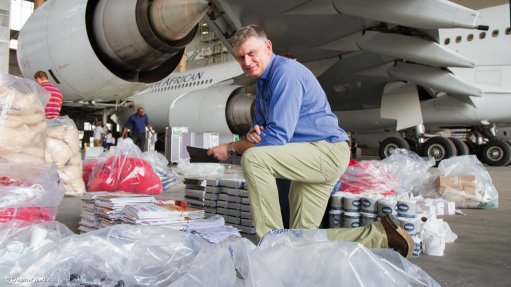
Captain Sandy Bayne
Photo by: Duane Daws/Creamer Media
As a sign of its commitment to cut costs, on Tuesday State-owned South African Airways (SAA) unveiled, in a hangar at the SAA Technical facility at OR Tambo International Airport, east of Johannesburg, a new initiative to the media. The initiative is to identify all unnecessary weight carried in the cabin of a wide body airline on intercontinental flights.
“The purpose of today is to start getting down to the nuts and bolts of how to make savings,” SAA acting CEO Nico Bezuidenhout told the assembled journalists. “Each kilo of weight we carry around that we don’t need adds fuel [expenditure]. Yes, these are small items, it won’t turn the airline around, but every little bit helps.”
The project involved an Airbus A340-600 airliner, which had returned from Munich, in Germany, on Tuesday morning. SAA personnel went through the cabin, removing all material and equipment they could find, including trolleys from the galleys, unused food and drinks, soaps, toilet rolls, blankets, headphones, in-flight magazines and so on. These were then weighed and the proportion that went unused established.
“For each kilo of weight saved [on an international flight], we save 300 g of fuel,” pointed out SAA head of fuel management Mark Vaughn. “On the Munich-Johannesburg sector the fuel cost is just under R1-million.” Of the airline’s fuel costs, 34% are hedged and 66% are free market. As a result, SAA has benefited from the fall in international oil prices in recent months. Over the past three or so months, the company’s fuel bill has fallen about 30%.
“SAA is in the middle of its 90 Day Action Plan. We’re trying to generate more revenue. Of course, we’re trying to cut costs. World prices of oil fluctuate in a manner that is not predictable. What is controllable is the weight of our aircraft,” affirmed SAA chief commercial officer Sylvain Bosc. “It’s very important for us to verify that what we have onboard [our aircraft] is necessary! The whole point of the exercise is: we know what we’re loading [into the aircraft cabins]; is it really all that necessary?”
“It’s an experiment,” SAA head of flight operations Captain Sandy Bayne told Engineering News Online. “For every 4 t of extra weight on an aircraft, we have to add about 2 t of extra fuel [on international flights]. [He pointed to a couple of cartons] Just these two fruit juice cartons weigh a kilo – and have gone all the way to Munich and back again and are still sealed. We’re trying to find out what we’re carrying out of habit instead of out of necessity. Without affecting safety and without adversely affecting the flight experience [of the passengers]. On this [Munich-Johannesburg] flight, half the business class headphones were not used. Many people seem to use their own. We’re also looking at making equipment lighter, while maintaining standards.”